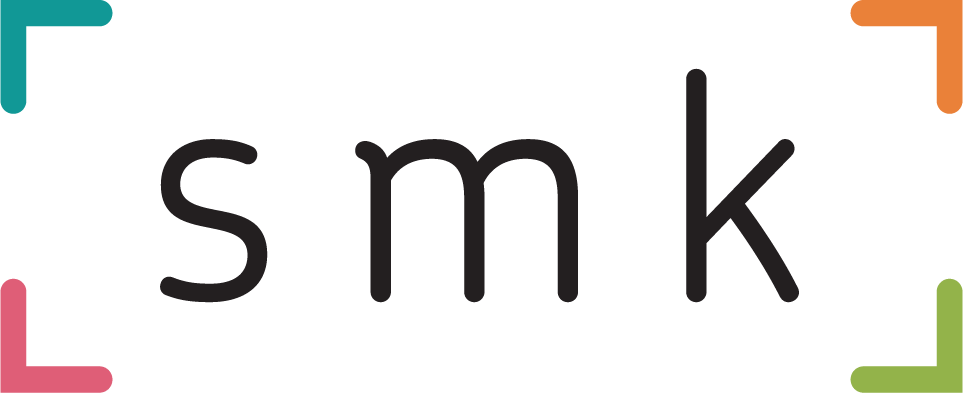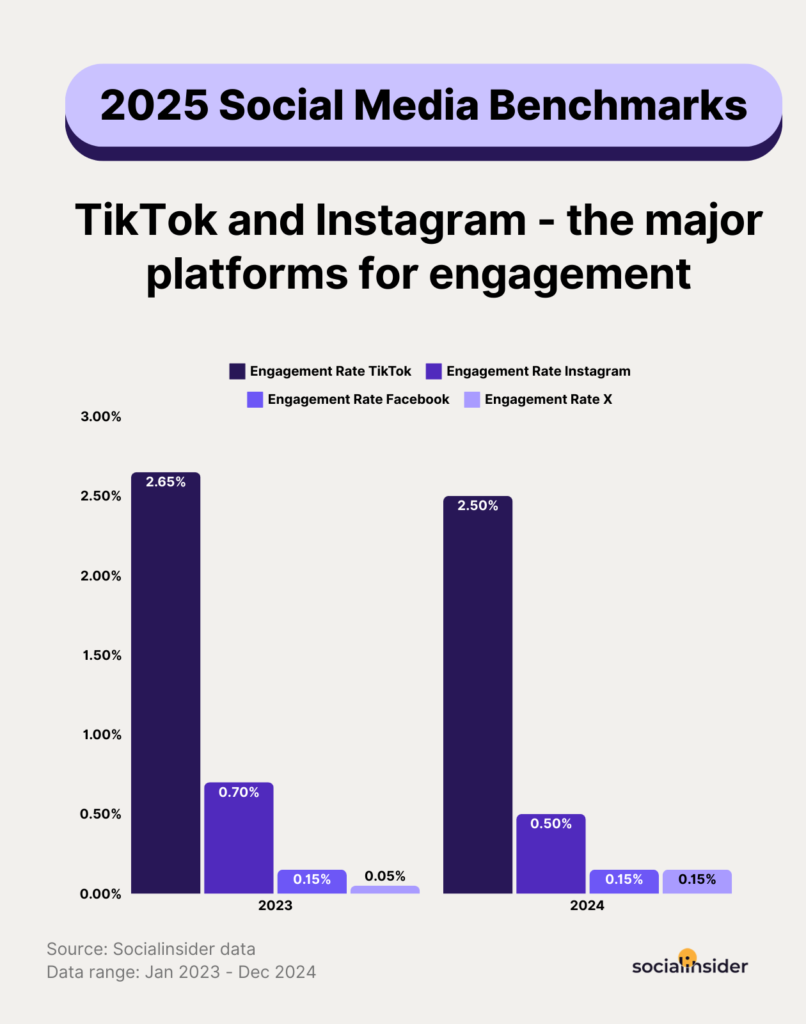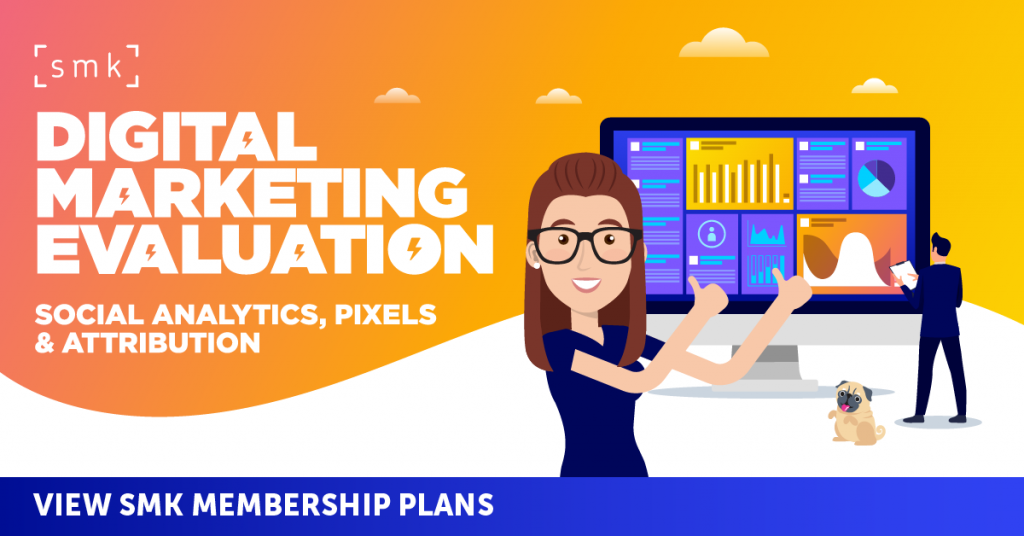Social media engagement is becoming more challenging as competition increases and user behaviours evolve. Brands can no longer rely on outdated tactics and must adapt to new platform trends to maintain visibility and interaction. A recent analysis of 125 million social media posts, published in the 2025 Social Media Benchmarks Report by Socialinsider, reveals where engagement is strongest, which platforms are declining, and how brands can refine their strategies for 2025.
TikTok Leads in Engagement, While Instagram Faces Decline
TikTok continues to dominate organic engagement, with an average engagement rate of 2.50% per post. Its algorithm prioritises content that sparks conversation and sharing, which has resulted in higher levels of interaction. TikTok posts receive an average of 3,092 likes and 66 comments, reinforcing the platform’s role as a key space for audience engagement.
Instagram, once a leader in social media engagement, has seen a 28% decline year over year. Engagement now sits at just 0.50%, with fewer users liking or commenting on posts despite a 13% increase in impressions. This suggests that while Instagram’s content reach remains strong, users are shifting towards more passive forms of engagement such as Stories, saves, and direct messages.
Facebook remains a challenge for organic engagement, with an average engagement rate of just 0.15%. Organic visibility continues to decline, making it increasingly difficult for brands to achieve success without paid promotion. However, Facebook Groups remain a valuable space for deeper audience interactions.
What These Trends Mean for Your Brand
TikTok remains the best platform for organic engagement, making it an essential part of any social strategy. Brands should focus on creating content that encourages interaction, such as response-driven videos, challenges, and behind-the-scenes insights. Rather than prioritising frequent posting, brands should aim for quality content that resonates with audiences.
Instagram still offers strong visibility, but engagement strategies must evolve. Reels, carousels, and interactive Stories perform better than static posts, while direct messages have become an important space for audience connection. Encouraging users to share content privately or engage through polls and Q&As can help maintain engagement despite declining public interactions.
Facebook’s organic reach is shrinking, but brands can still find value by focusing on community-driven content. Facebook Groups provide a more engaged space where brands can interact with audiences through discussions, live sessions, and exclusive content. Instead of relying solely on feed posts, brands should explore more interactive formats to stay relevant.
Shifting User Behaviour: More Silent Viewers, Fewer Public Interactions
The way users engage with content is changing. Many people now prefer to consume content passively rather than publicly liking or commenting on posts. This shift is particularly noticeable on Instagram, where users increasingly engage with content through Stories and direct messages rather than traditional likes and comments.
Facebook users are also moving their interactions into private spaces. While public engagement with brand pages is declining, Facebook Groups continue to see high levels of interaction, making them a valuable tool for community-building. TikTok, however, still encourages public interaction, with comment activity growing by 73% year over year.
Brands must adjust their strategies to align with these changes. Encouraging engagement through private messages, exclusive community content, and interactive Stories will become more important. Metrics such as saves, shares, and direct message interactions should be prioritised over traditional likes and comments.
Balancing Posting Frequency with Content Quality
Brands are adjusting their posting strategies based on platform performance, with some focusing on frequency while others prioritise quality. The latest data from Socialinsider’s report shows that:
- Instagram brands post an average of five times per week. Posting too often can reduce engagement, so brands should focus on high-impact content types like Reels and carousels.
- TikTok brands post an average of two times per week, yet achieve the highest engagement. This reinforces that well-crafted, engaging content is more effective than high posting frequency.
- Facebook brands post around seven times per week, but engagement per post remains low. More emphasis should be placed on interactive content such as live videos, group discussions, and community engagement.
Rather than increasing post volume, brands should focus on finding the right balance between consistency and engagement. Testing different posting schedules, monitoring engagement trends, and refining content strategies will yield better long-term results.
Preparing for the Future of Social Media
The social media landscape is shifting, and brands must stay adaptable. With the possibility of a TikTok ban in certain regions, businesses relying heavily on the platform should consider alternatives such as YouTube Shorts and Instagram Reels. Diversifying content across multiple platforms will help ensure continued brand visibility and engagement.
Email marketing and community-driven strategies are becoming increasingly important as engagement shifts towards private spaces. Rather than focusing solely on viral content, brands should prioritise long-term audience relationships through personalised interactions and valuable content.
As social media continues to evolve, success will come from flexibility, creativity, and a deep understanding of audience behaviour. Brands that embrace change and experiment with new engagement strategies will be best positioned to thrive in 2025 and beyond.
For a full breakdown of platform benchmarks and insights, read the 2025 Social Media Benchmarks Report by Socialinsider.




RECOMMENDED FOR YOU
[STUDY] ChatGPT Powers Work And Life
OpenAI, in collaboration with Harvard economist David Deming, has…
OpenAI, in collaboration with Harvard economist David Deming, has…
LinkedIn Tests New Premium Tools for SMBs
LinkedIn is quietly piloting a new Premium offering designed…
LinkedIn is quietly piloting a new Premium offering designed…
Meta Brings AI Video Editing to Instagram and Meta AI
Meta has launched a new AI-powered video editing feature…
Meta has launched a new AI-powered video editing feature…